Looney Tunes/Characters
Major Characters
Bugs Bunny
"Eehhh... What's up, Doc?"
The - well, the Bugs Bunny. No description needed.
Debut: "A Wild Hare" (1940), various, notably Tex Avery.
Tropes related to Bugs Bunny:
- See Bugs Bunny and Karmic Trickster.
Daffy Duck
"You're despicable!"/"WOO HOO, HOO HOO!!!"
Was originally The Screwball/Cloudcuckoolander, later Flanderized by Jones (and Freleng) into a Jerkass Small Name, Big Ego, most famously paired with Bugs as the Odd Couple. In this incarnation, used either as a foil for Bugs or to parody action-adventure heroes. Meanwhile McKimson combined the two interpretations and made Daffy into a Loveable Rogue. Later also joined Sylvester on the hunt for Speedy Gonzales.
Debut: "Porky's Duck Hunt" (1937), Tex Avery
Tropes related to Daffy Duck:
- See Daffy Duck.
Porky Pig

"Th-th-th-That's All, Folks!"
The Everyman and Straight Man to the rest of the cast, known for his ridiculously thick stutter. Often played a Deadpan Snarker or Butt Monkey, usually when paired with Daffy (either role depending on the latter's interpretation.
Debut: "I Haven't Got a Hat" (1935), Friz Freleng
Tropes related to Porky Pig:
- See Porky Pig.
Elmer Fudd
"Be vewwy, vewwy quiet! I'm hunting wabbits!"
One of only three humans in the regular cast (the others being Yosemite Sam & Tweety's owner Granny). The Butt Monkey, often Too Dumb to Live. An avid hunter, thus Jones' favorite adversary for both Bugs & Daffy, reaching a peak in the iconic Rabbit Season trilogy. Less popular with the other directors, who found him too wimpy. On a side note, he had an earlier, less distinctive prototype named Egghead, who was sometimes referred to as elmer.
On a side note, he didn't appear as often as most people think--in fact, he only appeared in about 36 of the original Bugs Bunny cartoons (although he did star in some of his own shorts, as well as other star characters cartoons).
Debut: "Elmer's Candid Camera" (1940), Jones.
Tropes related to Elmer Fudd:
- Affably Evil: Generally nice guy when not trying to blast (not-so-) innocent animals with his shotgun.
- Anti-Villain
- Arch Enemy: Bugs Bunny
- Art Evolution: His early Egghead look, plus his very brief change into a very obese design, before they settled into his standard look.
- Butt Monkey: Even outside antagonist roles his abuse never ends.
- Catch Phrase: "Shhh -- be vewy vewy quiet. I'm hunting wabbits."
- Crouching Moron, Hidden Badass: Had occasional Genre Savvy moments that took even Bugs by surprise.
- Designated Monkey: An example self-confessed by director Friz Freleng, who thought mild-mannered and dim-witted Elmer made Bugs look like a 'bully'.
- Elmuh Fudd Syndwome: Trope Namer.
- The Everyman: Seemed to replace Porky in this role in the fifties and sixties shorts.
- Foe Yay: Always seems to fall for Bugs' crossing dressing antics, no matter how paper-thin they may be.
- Harmless Villain
- Hidden Depths: Who would have guessed that the same Elmer Fudd that seemingly can't tell the difference between an actual woman and Bugs Bunny in a dress was an expert in economics? [1]
- Ineffectual Sympathetic Villain: But of course.
- My God, What Have I Done?: This is pretty much Elmer Fudd's reaction whenever he thinks he's finally killed Bugs. No matter how hard he's been trying throughout the episode to shoot Bugs he always breaks down in tears when he thinks he's finally done it, calling himself a murderer. Which calls into question why he's a hunter in the first place.
- About Elmer being a hunter despite feeling sorry for the animals he killed: in "Rabbit Fire," it was established that Elmer is a vegetarian and he hunts for the sport of it.
- Granted Elmer's usual "kill" amounts to shooting Daffy's bill off, his victim usually unharmed outside being somewhat annoyed.
- About Elmer being a hunter despite feeling sorry for the animals he killed: in "Rabbit Fire," it was established that Elmer is a vegetarian and he hunts for the sport of it.
- Team Rocket Wins: Actually got his revenge on "that wascawy wabbit" in Rabbit Rampage and Hare Brush. And then there's What's Opera, Doc?, wherein he seemingly kills Bugs.
- Too Dumb to Live
Tweety Pie
"I tawt I taw a puddy tat!"
In Clampett's hands, Tweety was a pink, sadistic trickster who used his wits to get rid of cats. Later, under Freleng, Tweety became yellow (the Hays Office balked because the pink made him look naked), found a recurring adversary in Sylvester, and often depended on an umbrella-wielding Granny or an angry bulldog to get rid of him. Time has made modern generations mistake him for a female.
Debut: "A Tale of Two Kitties" (1942), Clampett.
Tropes related to Tweety Pie:
- Arch Enemy: Sylvester
- Bitch in Sheep's Clothing: Cute little tweety bird on the outside, sadistic Karmic Trickster on the inside (though as time progressed, his innocence seemed to become more genuine.)
- Catch Phrase: "Dat bad old puttytat!"
- "I tawt I taw a puttytat!"
- "I did, I did! I did saw a puttytat!"
- Ping-Pong Naivete: One of Tweety's charms was that you could never tell whether he defeated Sylvester via Obfuscating Stupidity or inadvertantly through genuine child-like naïveté and dumb luck.
- Pint-Sized Powerhouse: In his earlier cartoons
Pepe LePew
A Funny Foreigner and Handsome Lech said to be the most foul smelling skunk in the world - or to his own kind, the best smelling - completely oblivious to his body odor problem... and thus to why all the beautiful 'young ladies' keep running from him in disgust.
His official pairing is now known as Penelope Pussycat, and she often has the misfortune of having a white stripe painted down her back, making Pepe go quite wild for her. It also seems that when he douses his foul scent and covers his white stripe (or accidentally paints himself blue), she can go quite wild over him, making him quite the Chick Magnet.
Debut: "Odor-able Kitty" (1945), Jones.
Tropes related to Pepe LePew:
- Abhorrent Admirer: One of the few rare male examples, and possibly the most popular when one wants to prove that not all Abhorrent Admirers are women who are ugly, fat, or insane.
- Anything That Moves: Sometimes even after learning he's been chasing a pussy cat he keeps going, covering up his white stripe or his stench.
- Pepe doesn't always go after anything painted black and white or dressed in skunk fur, but he does go after cats (which, when you think about it, becomes a very dirty Stealth Pun on "going after pussy[cats]"). Take "Past Perfumance." When the nameless cat jumps into a barrel of water, her stripe runs off. Pepe discovers that the cat he's been chasing all this time isn't a skunk, but does that deter him? Hell, no -- Pepe paints over his own stripe and continues the chase anyway. It should be noted, however, that Pepe Le Pew does fit this trope in the Looney Tunes comic books published by D.C. Comics, as a result of Flanderization.
- Black Comedy Rape: Dave Chappelle does see the Pepe cartoons like this according to the comedy special, "Killing 'Em Softly."
- Brother Chuck and Early Installment Weirdness: In Pepe's first cartoon, "Odorable Kitty," it's revealed in the end that Pepe is actually named Henry, has a wife and kids, and doesn't speak in a French accent. Pepe's wife and kids were never seen again after that.
- Chained Heat: The end of "The Cat's Bah" where Pepe somehow caught Penelope and chained her to his ankle.
- Chivalrous Pervert: Pepe's always saving (what he thinks are) female skunks from peril just so he can smother them with affection (cf. "For Scentimental Reasons," "Two Scents Worth," "Past Perfumance," and "A Scent of the Matterhorn.")
- Depraved Bisexual: At best, Pepe fits this trope (at worst, he's a Stalker with a Crush who goes after Anything That Moves as long as it's black and white striped. The D.C. Comics have him as either/or, depending on writer). In 1951's "Scentimental Romeo" had Pepe make out with a human man inside a Tunnel of Love ride. The man is so traumatized that he signs up for the French Foreign Legion and passes out. It Makes Sense in Context...sorta.
- Did Not Get the Girl: Believe it or not, there was a Pepe cartoon were Penelope runs off and Pepe doesn't continue the chase. That cartoon was 1951's "Scentimental Romeo" and the chase is interrupted when the zookeeper takes Pepe back to the zoo and Pepe bids a tearful farewell to Penelope.
- Everything Sounds Sexier in French: And it still sounds sexier even if said French is broken and full of Incredibly Lame Puns.
- French Jerk: I mean, really. He goes after a female cat (whom he thinks is a skunk) and just smothers her with affection without any regard for her feelings. Naturally, this can be excused as it's all unintentional and hilarious.
- Getting Crap Past the Radar: Why didn't the Hayes Office go after Chuck Jones and Michael Maltese for "Wild Over You," where an escaped wildcat from the zoo becomes Pepe's unknowing (and unwilling) object of desire and the wildcat fights back, only to have Pepe comment on how he likes it? I thought sexual perversion (in this case, masochism) in movies was considered taboo in those days.
- Handsome Lech: If it weren't for Pepe, other examples like Glen Quagmire or Johnny Bravo probably wouldn't have been created.
- Hypocritical Humor: Pepe begging Penelope to control herself when she goes after him on "For Scentimental Reasons" and "Little Beau Pepe."
- Casanova Wannabe: The beginning of 1954's "The Cat's Bah," when he's being interviewed by the unseen reporter in a parody of the original TV show version of "The Continental," years before Christopher Walken would do it on Saturday Night Live.
- No Guy Wants to Be Chased: Pepe often panics when the tables are turned on him.
- This aspect of Pepe's character was based off of a close friend of Chuck Jones who was a ladies man who liked to be upfront and in control of women but when they were flirtatious back at him he got nervous. Pepe is basically a representation of this friend, he puts on a good front but doesn't know how to receive romance.
- Smelly Skunk: Naturally
- Spiritual Successor/Distaff Counterpart: On Tiny Toon Adventures, there's Fifi La Fume, who acts just like Pepe (except that she likes it when men go after her), right down to mistaking black-and-white striped animals for male skunks (though it was revealed that she has a crush on Pepe Le Pew during an episode where Elmyra thinks Fifi is a kitty).
- Stalker with a Crush: So. Very. Much.
- Too Kinky to Torture: A lot of the Pepe cartoons have Pepe brushing off the cat's violent attempts at deterring him as "flirting." 1953's "Wild Over You" is the definitive cartoon for proof of this trope.
- Write Who You Know: In one of Chuck Jones's autobiographies (Chuck Jones is the guy who created Pepe Le Pew, in case anyone didn't know), he states that animation writer Tedd Pierce was this Casanova Wannabe type guy who would always hit on women and chalk up their rejection of him as "She's flirting" or "She's playing hard to get." This, coupled with exaggerating the stereotype of "zee great French lovair" and Chuck Jones's own insecurities about picking up women, is the basis of Pepe's persona.
Sylvester J. Cat
"Sufferin' succotash!"
A cat with a speech impediment who usually tries to eat Tweety or Speedy Gonzales, with little success. One of the most versatile of the ensemble, prone to neuroses and usually the star of the comic melodramas. In Robert McKimson's hands, the more slobby Sylvester has a hyper-articulate son named Sylvester Jr., whom Dad tries to impress by chasing what turns out to be a baby kangaroo into another room; when he retreats gibbering at the 'giant mouse!'. Junior is mortified. On a side note, he was technically a creation of Bob Clampett's unit, as evidenced by him appearing in one of Clampett's last theatrical cartoons, "Kitty Kornered". Obviously, Freleng's take on Sylvester is the one everybody remembers.
Debut: "Life With Feathers" (1945), Freleng.
Tropes related to Sylvester J. Cat:
- Anthropomorphic Shift: One-time example in "The Scarlet Pumpernickel"; Sylvester as the Grand Duke is a full-blown Funny Animal
- Affably Evil: A vicious predator, but a loving father to Sylvester Jr, and with often the same on-off friendly banter towards his prey as the rest of the Rogues Gallery. He also occasionally goes through the same pangs of conscience as Elmer when he thinks he has succeeded in killing them.
- Anti-Villain
- Arch Enemy: Tweety.
- Bumbling Dad: He means well, but his general clumsiness and ineptitude is the cause of Sylvester Jr.'s embarrassment.
- Butt Monkey: Claimed less victories than even Elmer or Daffy on his later shorts alone.
- Catch Phrase: "Sufferin' succotash."
- Cats Are Mean: Though granted it rarely went outside a cat's natural instincts for food, and it doesn't stop sadistic birds, mice and dogs abusing him beyond (or sometimes even without) provocation (eg. Canned Feud, Scaredy Cat).
- Cool Cat: He occasionally plays with this, particularly in cartoons where Tweety isn't involved.
- Ineffectual Sympathetic Villain
- Laser-Guided Karma: While hopeless at catching prey like Tweety and Speedy, there are odd cases where Sylvester is forced to protect his potential prey, at which point he is often quite competent (eg. A Mouse Divided, 'Father Of The Bird). He is still usually robbed of a full victory at the end of it though. Such cases also often double as a Crowning Moment of Heartwarming.
- Speech Impediment: "Thufferin' Thuccotatch!"
- Suddenly Voiced: Inverted. He could usually speak (albeit with his famous speech impediment), but a few later cartoons cast him as Porky's pet, and in these he was a Heroic Mime.
- His speaking role seemed to depend on character, since he was classified as a pet, he usually did not communicate with owners or humans but could make conversations with fellow pet classified animals like Tweety. For other animals with more human roles like Daffy and Porky it was free-game and Depending on the Writer (though mute in Scaredy Cat, Sylvester spoke normally to Porky in Kitty Cornered and The Scarlet Pumpernickel for example).
- Talking to Himself: Though this can refer to most of the cast, this was especially notable on the occasions paired with Daffy, who had the same speech pattern as Sylvester, only sped up after recording (e.g. The Scarlet Pumpernickel, The Yolks On You).
- Team Rocket Wins: With some assistance from Speedy Gonzales, Sylvester chalks up a win in "A Message To Gracias."
Yosemite Sam
"OOOOOHHHH, AHHH HATES RABBITS!!!"
A brash little outlaw with handlebar mustachios and a severe temper problem, introduced as 'a more Worthy Adversary' for Bugs than the meek Elmer. Said to be a caricature of his (short, brash, redheaded) creator. Introduced as a cowboy bandit, he eventually became the stock blowhard villain character: Civil War general, Viking, Pirate, The Black Knight (no Python references please), politician, an Arab sheikh, etc. Oddly enough, he wears his bandit mask no matter what role he plays.
Debut: "Hare Trigger" (1945), Freleng.
Tropes related to Yosemite Sam:
- Arch Enemy: Bugs Bunny is this to him, but it doesn't work both ways (Bugs' arch-enemy being Elmer Fudd)
- Bandito: Sam aappears as Mexican bandito 'Pancho Vanilla' in the Speedy Gonzales short "Pancho's Hideaway".
- Evil Is Hammy: "I'M THE FASTEST GUN NORTH, SOUTH, EAST, AAAANNNNDDD WEST OF THE PECOS!"
- Expy: The De Patie Freleng short Panchos Hideaway features the bandit Pancho Vanilla, who matches Sam in terms of personality, role and design; Pancho's largest differences are his darker facial hair and Mexican accent.
- Glass Cannon
- Hair-Trigger Temper
- Harmless Villain : Ironically offered as little a challenge to Bugs as Elmer at times.
- Jerkass: Was created largely to get the audience to root for Bugs.
- The Napoleon
- No Indoor Voice
- Recycled in Space: Has appeared in almost every stock villain role throughout his run, albeit always maintaining his bandit mask and western dialect
- Literally in "Lighter Than Hare".
- Worthy Adversary: Created as a more formidable villain compared to Elmer - it didn't quite last, however.
Foghorn Leghorn
"What in tha- I say, what in the Sam Hill is goin' on here?"
A loud, obnoxious rooster with a Southern accent, based on Fred Allen's 'Senator Claghorn' radio character. Considers himself the life of the party, as demonstrated by tricking a baby chicken-hawk out of capturing him, abusing Mandrake the barnyard dog by whomping him with a wooden board and painting his tongue green, or babysitting a genius chick named Eggbert in order to cozy up to his widow hen mother.
Debut: "Walky Talky Hawky" (1946), McKimson
Tropes Related to Foggy:
- Tropes related to him can be found on the Foghorn Leghorn page.
Marvin the Martian
"I claim this planet in the name of Mars! Isn't that lovely?"
An Ineffectual Sympathetic Villain who wants to see an Earthshattering Kaboom, and is the Trope Namer thereof (albeit invariably foiled by Bugs).
Debut: "Haredevil Hare" (1948), Jones.
Tropes related to Marvin the Martian:
- Affably Evil: Marvin was originally conceived as the opposite of Yosemite Sam, so he's always been a quiet, reserved, polite character who can still pose a threat.
- Aliens Are Bastards: He was willing to kill billions of lives just because the Earth was blocking his view of Venus.
- The Bad Guy Wins: see "Team Rocket Wins" below
- Catch Phrase: "This makes me very angry!"
- Ineffectual Sympathetic Villain
- No Name Given: He was unnamed in the original cartoons (the model sheets only giving him the moniker of "The Martian") but was officially named Marvin when he they started making merchandise of him.
- Team Rocket Wins: Seemingly achieves his goal of detonating the earth in the original full-version of Duck Dodgers and the Return of the 24th and a Half Century. With Dodgers distracted from his duties and earth's destruction almost certain, Marvin is left with no choice but to ensure the viewers "it's only a cartoon".
- The Faceless
- The Stoic: "This makes me VERY angry."
- That Makes Me Feel Angry: Subverted; he has a wide range of facial expressions, despite practically quoting the trope repeatedly.
- Worthy Adversary: After Yosemite Sam failed to challenge Bugs. Though still a hapless villain, he was slightly more formidable.
Wile E Coyote and The Road Runner
"MEEP MEEP!""BEEP BEEP!"
A speedy bird and the coyote who uses a variety of backfiring Acme Company traps and mail-order gadgets to try to catch him - 'try' being the operative word. The coyote was named when he had some cartoons facing off against Bugs instead of Roadrunner, where he became "Wile E. Coyote, Super Genius" - the Road Runner remains mute to this day (meep-meep!) as he is now the mascot for Time Warner Cable.
Debut: "Fast and Furry-ous" (1949), Jones.
Tropes related to Wile E. Coyote (Bugs Bunny cartoons only, for Wile E. And Roadrunner cartoons see Wile E Coyote and The Road Runner:
- Badass Adorable: Inverted with Wile E., as he is neither as threatening, nor as cute, as real-life coyotes.
- Catch Phrase: "Genius, pure genius!"
- The Chew Toy
- The Determinator
- Evil Cannot Comprehend Good: When Bugs refuses his offer to get eaten, Wile E. comments of why does he wanted to do it the hard way.
- Faux Affably Evil: He first meets Bugs in a nice way, but tries to get him to say his prayers while the said meeting.
- Gadgeteer Genius: if not for the fact that all of his constructions inevitably fail.
- Ineffectual Sympathetic Villain: And how!
- Iron Butt Monkey: And how!
- Oh Crap: Practicaly his default facial expression
- Small Name, Big Ego: He likes to call himself "Wile E. Coyote: Genius".
- Suddenly Voiced: When teamed up with Bugs Bunny (except Hare Breadth Hurry that otherwise played like a traditional Road Runner short).
- Talking with Signs
Tropes related to the Road Runner:
Speedy Gonzales
"Arriba! Arriba! Andale! Andale!"
Another Funny Foreigner and good-natured Trickster who moves at Super Speed to help his poor Mexican mouse friends get cheese from "el gringo pussygato" (usually Sylvester). Has a lethargic cousin named (inevitably) "Slowpoke Rodriguez" who uses a gun to incapacitate cats instead. For obvious reasons, the Speedy shorts — particularly the late 1960s ones with Daffy as his antagonist — tend not to be received well by animation fans and historians.
Debut: "Cat-Tails for Two" (1953), McKimson.
Tropes related to Speedy Gonzales:
- Arch Enemy: Sylvester is this to him, but it doesn't work both ways (Sylvester's Arch Enemy being Tweety Pie)
- Bumbling Sidekick: Oddly enough plays this role for Daffy in Daffy Duck's Fantastic Island.
- Catch Phrase: "Arriba! Arriba!"
- Chivalrous Pervert: His eyes for female mice has gotten him in trouble with the other rodents on occasion.
- Early Installment Weirdness: In Speedy's first cartoon, "Cat-Tails for Two," Speedy looked way different than how he looks now. The "Speedy" in "Cat-Tails for Two" had a gold tooth, a pink shirt with no pants, and came off as more of a Mexican stereotype than his current form.
- Invincible Hero: Leaned towards this (his Super Speed made him near untouchable by antagonists such as Sylvester (the odd occasion the cat actually placed the mouse in his mouth he often merely charged with enough power to rip (harmlessly) through his tail, suggesting it was actually physically impossible for Sylvester to eat Speedy).
- A possible reason for Daffy's more malicious persona during the De Patie Freleng era was to remedy this trope and utilise a greater malice that Speedy could come off as more sympathetic and fallible against (much akin to Yosemite Sam replacing the more pitiful Elmer Fudd as Bugs' enemy). While still a bumbling loser, Daffy often managed to genuinely challenge and intimidate Speedy much more often than Sylvester did previously. In a couple of cases Speedy even ended up the loser of the short.
- Karmic Trickster
- Laser-Guided Karma: A cunning Karmic Trickster when working to benefit his innocent mouse amigos, though often a somewhat simple Minion with an F In Evil when working with less scrupulous co-stars such as Daffy and Witch Hazel.
- Nice Hat
- Ping-Pong Naivete: Similar to Tweety, while often more a cunning Karmic Trickster Obfuscating Stupidity, there are times when Speedy genuinely comes off as incredibly naive. His unrequited attempts to make peace with the then-plainly hateful Daffy have an almost tragic tone at times (eg. Moby Duck).
- Super Speed
- Vitriolic Best Buds: With Daffy. Type 2.
- With Friends Like These...: With Daffy.
The Tasmanian Devil (Taz)
The destructive, hurricane-spinning, feral, Extreme Omnivore who talks in Hulk Speak, when he talks at all. He'll eat anything, buzzsaw through anything, and moves at whirlwind speed.
Debut: "Devil May Hare" (1954), McKimson.
Tropes related to Tasmanian Devil:
- Astonishingly Appropriate Appearance: His hair resembles devil horns. He spins like a whirlwind, which is also called a "dust devil".
- Big Ol' Unibrow
- Everything's Better with Spinning
- Extreme Omnivore: It's pretty extreme that Taz can eat dynamite without it killing him.
- Executive Meddling: Producer Eddie Selzer, head of the Warner Bros. animation studio, ordered McKimson to shelve the character since he felt Taz was "too obnoxious." He was overruled by studio head Jack Warner when he asked what had happened to the character. Warner saved Taz's career when he told Selzer that he had received "boxes and boxes" of letters from people who liked the character and wanted to see more of him.
- Fan Nickname: Rare canon-made example, the nickname "Taz" (first used by Daffy in Ducking The Devil) was derived from fan-mail asking for more shorts featuring "this Taz-boy".
- Flanderization: While never bright, he's gotten alot dumber over the years.
- Fluffy the Terrible
- Ineffectual Sympathetic Villain
- Hulk Speak: When Mel Blanc asked "What does he sound like?" when he first voiced the character and was told, "Nobody has ever heard one." So he was compelled to ad-lib some kind of glottal-guttural gravelly gargle, now lovingly described as "Taz-speak."
- Music Soothes the Savage Beast: His weakness.
- Spin-Off: During the 90s he was given his own show, Taz-Mania, which cast him with a sitcom-like family.
Michigan J. Frog
A frog from The Gay Nineties is discovered by a man in modern times. Unfortunately, the frog acts as his Not-So-Imaginary Friend. Listed here as an honorable mention, as he only ever appeared in one cartoon, which he didn't share with any other iconic characters, and was never really iconic himself until he became the mascot for The WB Network in the 90's.
Debut: "One Froggy Evening" (1955), Jones.
Tropes related to Michigan J. Frog:
- Nice Hat
- Not-So-Imaginary Friend: More a trait than the character itself, everyone sees the frog, only one person sees it's singing talent.
- One-Shot Character: Well, at least until Another Froggy Evening, decades later.
- Really Seven Hundred Years Old: Has survived in a box for several years since the age of cavemen.
- You Didn't Ask: Seems to be implied in Another Froggy Evening when met by Marvin the Martian, who can speak "Frog"/"Martian" and thus can just ask him to sing for him.
- Sealed Good in a Can: Although it wasn't clear until the end of "Another Froggy Evening".
Early Characters/Secondary Characters
Bosko the Talk-Ink Kid

The original star character of the Warner Bros. cartoon studio, created by Hugh Harman and Rudolph Ising as the studios answer to Mickey Mouse. While Bosko had little to no personality, he was fairly popular during the early 30's. He later migrated with his creators to MGM in 1933, where he made a few more appearances (complete with a full on redesign into a black kid) in their Happy Harmonies cartoons before being abandoned altogether. He managed to make one last appearance in the Tiny Toon Adventures episode "Fields of Honey", although he was redesigned to have dog ears, obviously due to the stir it would cause seeing a cartoon caricature of a black person in today's society.
Debut: "Bosko, the Talk-Ink Kid" (1929)
Tropes:
Foxy

A shameless Mickey Mouse clone made by former Disney employee Rudolph Ising to be the headlining star of the Merrie Melodies series. Appearance and personality was nearly indistinguishable from Mickey, although Foxy was noticably more agressive. Only lasted for three shorts, as Walt Disney quickly got wind of the ripoff and personally asked Rudy to stop using him. He DID made a brief return in the Tiny Toon Adventures episode Two-Tone Town, however.
Debut: Lady, Play Your Mandolin! (1931)
Tropes:
- Captain Ersatz: As mentioned already, he is one of the most blatant attempts at ripping off of Mickey Mouse ever done. His image is even adorned on the Captain Ersatz page.
- The Everyman: Foxy was a gallopin', beer guzzling gaucho in his first short, a trolley driver in the next (although that was All Just a Dream) and a traffic cop in his final short.
- Flat Character
- Killed Off for Real: Possibly in the ending of "One More Time", when he is sneak attacked from behind by a gangster with a tommy gun, although we don't get to see the aftermath of the sneak attack. Might be an in-universe explanation for why Foxy didn't appear in anymore cartoons.
- Retraux: The episode of Tiny Toons he appeared in, along with his girlfriend Roxy, served as a throwback to cartoons from The Golden Age of Animation, right down to everything being in black & white.
Piggy

A Captain Ersatz of Foxy after legal issues forced the former character into early retirement. Like all of Harman and Ising's characters, he was nondescript in personality. He made two appearances in the Merrie Melodies series, in "You Don't Know What You're Doin'" and "Hittin' The Trail for Hallelujah Land". On another note, another character appeared a few years later that was also called Piggy in the Friz Freleng cartoon "Pigs is Pigs", although this character was a gluttonous little kid who had nothing in common with this earlier character.
Debut: "You Don't Know What You're Doin'!"
- Captain Ersatz: Of Foxy.
- Flat Character
Goopy Geer
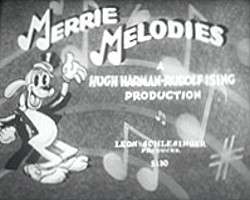
A happy go lucky pianist with loads of talent and a real crowd stealer. Has an slight resemblance to Goofy, but in this case, Goopy Geer came about a month before Goofy (or, Dippy Dawg as he was known then) appeared in "Mickey's Revue." Only lasted four shorts and was the last attempt of the original Harman and Ising operated animation studio to make an original character. However, he also make a brief comeback along with Foxy in Tiny Toon Adventures Two-Tone Town.
Debut: Goopy Geer (1932)
Buddy
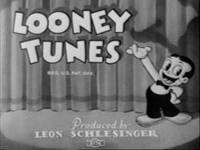
A Captain Ersatz of Bosko the Talk Ink Kid that was hastily created after Harman and Ising split with Leon's studio and took the rights to Bosko with them. His shorts are noteworthy, if only for being some of the blandest, dullest cartoons to come from that time period. He made a brief comeback in the Animaniacs episode "Warners 65th Anniversary Special", in which he tried to inflict revenge on the Warner siblings, who in their universe, destroyed Buddy's career. (they were brought in to spice up his boring cartoons, via hitting him in the head with a mallet over and over again) Voiced by Jim Cummings in the latter special.
Debut: Buddy's Day Out (1933)
- Butt Monkey: In the Animaniacs universe, the Warner Bros. and Sister got their starring roles by starring cartoons consisting of whacking Buddy in the head with a mallet over and over again.
- Captain Ersatz: Of Bosko. Bob Clampett even jokingly nicknamed him "Bosko in Whiteface".
- Flat Character: Until his comeback, when he got a little more personality.
- Stepford Smiler: Prior to him revealing his evil plans in the Warners 65th Anniversary Special.
- Took a Level in Badass: In the Warners Special. Keep in mind, he has the exact same voice as Pete and Dr. Robotnik!
Beans the Cat
"Beans is the name, one of the Boston beans!"

One of several characters made by Friz Freleng in a desperate attempt to reinvigorate their studio, Beans the Cat was meant to be the big star of the studio--only for that position to go to Bean's sidekick, Porky Pig. Beans was initially somewhat popular, likely because he had a rebellious streak that Buddy was sorely lacking, but as that aspect of his personality faded, so did his popularity.
Debut: "I Haven't Got a Hat" (1935, Freleng)
- Chuck Cunningham Syndrome
- Cute Kitten
- Flat Character: He had at least something resembling a personality when directed by Freleng, or in his sole outing for Tex Avery. Unfortunately, Jack King (who directed most of his shorts) tended to play him as a feline version of Buddy, ensuring that he got eclipsed by Porky.
- Karmic Trickster: In his first couple of shorts.
- Punny Name: He and Porky's names were a play on "Pork N' Beans".
Ham and Ex

Two puppy twins that were part of Friz's attempt to make a batch of star characters for the studio. Obviously didn't last long.
Debut: "I Haven't Got A Hat" (1935, Freleng)
Oliver Owl
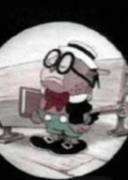
Debut: "I Haven't Got a Hat" (1935, Freleng)
The fourth member of the batch of characters Friz Freleng made for "I Havent Got a Hat".
- Flat Character: You should know by now that the original shorts went through a LOT of dud characters before we got the stars of today.
- The Owl-Knowing One: Implied, but never shown. He seems at least smart enough to be a film director, as shown in "Hollywood Capers".
- Smart People Wear Glasses
Kitty
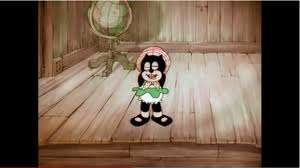
Debut: "I Haven't Got a Hat" (1935, Freleng)
The fifth member of Friz's group of characters for "I Havent Got a Hat". Served as a love interest for Beans on one occasion, as well as the daughter of Porky Pig in one short.
Gabby Goat

Created as an attempt to serve as a comic foil for Porky Pig, Gabby Goat was a short tempered jerk that was essentially the Looney Tunes answer to Donald Duck in terms of character. However, audiences found him too unlikable to be a hit, and in order for his chemistry with Porky to work, the latter character had to be derailed into a bumbling idiot, which was a no go, so Gabby was quickly phased out, with Daffy Duck serving as Porky's more appropriate foil later down the road.
Debut: "Porky & Gabby" (1937, Ub Iwerks)
Happy Hare/Bug's Bunny/Bugs Bunny Prototype
"You don't have to be crazy to do this, but it sure helps!"
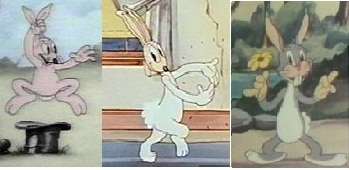
Originally created by Ben Hardaway as a Captain Ersatz for Daffy Duck, this rabbit character shares many of the same traits as Daffy, but also serves as a very early prototype for the later, more fleshed out Bugs Bunny. But wheras Bugs was more defensive, Genre Savvy and collected, this wild hare was loaded with motivation and energy and went out causing trouble on sheer principle, although Hare-Um Scare-Um showed us that he could be just as resourceful as the later Bugs. This prototype appeared in five shorts: "Porky's Hare Hunt", "Hare-Um Scare-Um", "Presto Change-o", "Patient Porky" (in the opening) and "Elmer's Candid Camera".
When Hardaway left Warner Bros. for the Walter Lantz cartoon studio, he would later take the traits of this character and use them to create Lantz's biggest star of the 40's, Woody Woodpecker.
Debut: "Porky's Hare Hunt" (1938, Ben Hardaway)
- Annoying Laugh: In fact, the same laugh that Mel Blanc used when he went on to voice Woody Woodpecker, but not sped up.
- Art Evolution: He started off looking like a tiny white rabbit, but by 1939 he had sprouted apricot fur and started looking more like the Bugs we remember.
- Captain Ersatz: Woody Woodpecker is one of this prototype.
- The Cameo: Popped up early in "Patient Porky", made a blink and you'll miss it cameo in Who Framed Roger Rabbit?, and was going to appear in Looney Tunes: Back in Action in the original ending until that ending was scrapped; said ending can be seen as an extra on the DVD).
- Cloudcuckoolander: In "Hare Um Scare Um", he is unabashedly crazy and proud of it.
- Fan Nickname: Proto-Bugs.
- Hammerspace: One distinguishing trait this character had was that he could pull objects out of thin air like magic in "Presto Change-O" and "Hare-Um Scare-Um", something that would be integrated into the fully realized Bugs Bunny.
- Jerkass: Especially in "Elmer's Candid Camera", where the Proto-Bugs heckled poor Elmer just because he was taking pictures of wild life. He was probably the reason why Elmer took up hunting in the first place.
- Pint-Sized Powerhouse: He was very small in his first three appearances, but very strong and fast. "Elmer's Candid Camera" brought him up to about as tall as Elmer, however.
- Screwy Squirrel: One of the earliest examples.
- Super Strength: A mild example, but in Porky's Hare Hunt, he snapped Porky's rifle like a twig.
Sniffles The Mouse
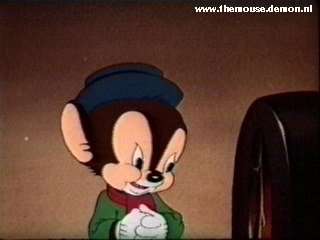
Early creation of Chuck Jones, a ridiculously cute, naive little mouse that often obliviously wandered into danger's way. As the shorts transitioned into zanier humor, attempts were made to evolve Sniffles accordingly, flanderizing him into a Karmic Trickster with a Motor Mouth, though the character was ultimately phased out (though still had a healthy run in the comics.) His motor mouth version made a brief speaking appearance in Space Jam.
Debut: "Naughty But Mice" (1939), Jones.
Tropes:
- Motor Mouth: In his later shorts Chuck Jones transformed the cute little mouse into a Screwy Squirrel/Karmic Trickster who would just never stop talking.
- Ridiculously Cute Critter: Jones created the character during the early period in his career when he was still heavily influenced by Disney's Silly Symphonies shorts.
- Small Annoying Creature
Cecil Turtle
Slow paced (but quick-witted) turtle that rivals Bugs Bunny. One of the few characters to consistently defeat Bugs, in shorts that were based on the fable The Tortoise and The Hare.
Debut: "Tortoise Beats Hare" (1941)
Tropes:
- Affectionate Parody: The three shorts are probably these of the Silly Symphonies version of "The Tortoise and the Hare".
- The Cat Came Back
- Crouching Moron, Hidden Badass
- Evil vs. Evil: Both he and Bugs are willing to play crooked in order to beat each other.
- Removable Shell
- The Rival: To Bugs.
- Turtle Power
Mac and Tosh, the Goofy Gophers
- Ambiguously Gay
- Overly Polite Pals
- Stan Freberg: Voiced Tosh.
Debut: "The Goofy Gophers" (1947)
The Three Bears
Debut: "Bugs Bunny and the Three Bears" (1944)
- Christmas Cake: Mama Bear, as Bugs discovered to his horror in "Bugs Bunny and the Three Bears".
- Hair-Trigger Temper: Papa Bear.
- Hilariously Abusive Childhood: Junior is repeatedly punched or bludgeoned by Papa Bear for his stupidity.
- Jerkass: Papa Bear.
- Man Child: Junior.
- Simpleton Voice: Again, Junior.
- Spiritual Successor: Baby Huey.
- Stan Freberg: Voiced Junior.
- Too Dumb to Live: Once again, Junior.
- Write Who You Know: Chuck Jones apparently based Papa Bear off of his own father.
Henery Hawk
Debut: "The Squawkin' Hawk" (1942)
- Pint-Sized Powerhouse: He can effortlessly take down ol' Foggy, even though he's only a measly few inches high!
Granny
A seemingly harmless elderly woman; owner of Tweety and occasionally Sylvester (or whatever other animal the cartoon calls for).
Debut: "Little Red Walking Hood" (1937)
Tropes:
- Breakout Character: Is arguably more the lead protagonist of Sylvester and Tweety Mysteries than the title pair.
- Mama Bear: Do not mess with her pets.
- Never Mess with Granny: She isn't the Trope Namer but she might as well be.
- Ping-Pong Naivete: Depending on the short, Granny can be extremely wily and perceptive in foiling Sylvester, or completely oblivious that her beloved cat is anything but best friends with Tweety.
Killer the Buzzard/Beaky Buzzard
An absentminded buzzard who lives with his momma in the distant desert. Appeared in three shorts. Came back as a background regular in Space Jam, and made a cameo in "Looney Tunes: Back in Action".
Debut: "Bugs Bunny Gets the Boid" (1942)
- Momma's Boy
- The Runt At the End
- Simpleton Voice
- Super Strength: Like his brothers, he's strong enough to carry something as large as a dragon back to his nest.
- Too Dumb to Live: That said, he can catch a baby bumblebee.
Marc Antony and Pussyfoot
A large dog and a little kitten. The former is very protective of the latter.
Debut: "Feed the Kitty" (1955)
Tropes:
- Angry Guard Dog: Marc Antony tries to represent this in their first meeting. It fails miserably.
- Badly-Battered Babysitter: Poor Marc Antony.
- Big Friendly Dog: It's no good denying it, Marc Antony.
- Cats Are Mean: Averted. Pussyfoot does get Marc Antony in trouble but s/he doesn't seem to do it on purpose.
- In several of their shorts, Claude Cat serves as an antagonist, usually trying to harass or abuse Pussyfoot and pin the blame on Marc Anthony.
- Gentle Giant: Marc Antony.
- Huge Guy, Tiny Girl
- Ridiculously Cute Critter: Pussyfoot.
Witch Hazel
Debut: "Bewitched Bunny" (1954)
- Hotter and Sexier: In the end of "Bewitched Bunny", when her ugliness is turned into beauty.
- Hot Witch: A hot witch rabbit in the end of "Bewitched Bunny".
- Large Ham: "EEEHEEHEEHEEHEEHEHEEHEEHEEHEEHEE!"
- Punch Clock Villain: Has a pretty normal life (for a witch, anyways) when she's not trying to cook Bugs or Daffy.
- Wicked Witch: Parody of the trope.
Gossamer
A lumbering mass of red hair wearing sneakers. Gossamer almost exclusively plays the role of a nigh invincible monster in his few appearances, and is mostly a brutish foil to Bugs Bunny.
Tropes:
- Determinator
- Family-Unfriendly Death: That one time when he gets shaved into oblivion. Leaving only his sneakers.
- Go Mad from the Revelation: Bugs once scared him off by making him realize that he was currently being watched by possibly thousands of people this entire time (read: the viewers). He proceeded to run screaming to get away. Through several walls.
- Lightning Bruiser
Cool Cat
Debut: "Cool Cat" (1967)
Merlin the Magic Mouse
Debut: "Merlin the Magic Mouse" (1967)
- The Other Darrin: Was voiced by Daws Butler in his first appearance only, then by Larry Storch for the remainder of his cartoons.
Pete Puma
Debut: "Rabbit's Kin" (1952)
- Paper-Thin Disguise
- Stan Freberg: Voiced Pete.
- Verbal Tic
Playboy Penguin
Debut: "Frigid Hare" (1949)
Tropes:
Rocky and Mugsy
Debut: "Racketeer Rabbit" (1946)
The Crusher
Debut: "Rabbit Punch" (1948)
Hubie and Bertie
Debut: "The Aristo-Cat" (1943)
Tropes:
- Jerkass: Especially in Mouse Wreckers.
- Screwy Squirrel
Claude Cat
Tropes:
- Butt Monkey
- Cats Are Mean
- Punny Name
- Took a Level in Jerkass: After his run with Hubie and Bertie ended, he became a jealous foil for Frisky Puppy and Pussyfoot.
Charlie Dog
Hyperactive and incredibly clingy mutt that is constantly searching for a home and master. With mannerisms not distant from those of a slick-talking salesman, Charlie goes to extremes to be accepted by his potential master (usually Porky Pig) who are often equally determined to get him off their backs. Debut: "Little Orphan Airdale" (1947), Jones (Note however that the plot and character seems to be heavily based on that of the earlier "Porky's Pooch" (1941), Clampett)
Debut: "Little Orphan Airdale" (1947) [2]
Tropes:
- The Cameo: Made an appearance in "Dog Tales". However, this appearance was mostly recycled from "Often an Orphan".
- Determinator: He won't take "no" for an answer, EVER.
- Dogged Nice Guy: A non-romantic example.
- Loveable Rogue: Though like Daffy, he can act less than lovable in his schemes at times.
- Too Many Halves: He describes himself this way in a Running Gag.
I'm 50% Pointer (There it is! There it is! There it is!), 50% Boxer, 50% Setter (Irish Setter), 50% Watch Dog, 50% Spitz, 50% Doberman Pincher. But, mostly, I'm all Labrador Retriever!
Penelope Pussycat
The (collective?) name for the poor kitty who finds herself the object of Pepe's affections. Debut: "For Scentimental Reasons" (1949), Jones.
Tropes:
- All There in the Manual: Penelope's name (while referred to in "The Cat's Bah") was inconsistent until promotional art for "Carrotblanca" confirmed it.
- Beware the Nice Ones: Usually timid in personality, though she can turn violent if harassed for long.
- Crack Pairing: In-Universe example in "Carrotblanca", where Penelope gets paired with Bugs Bunny.
- Shrinking Violet: Usually rather meek in personality, though when smitten she can be as equally brash as Pepe.
- You Look Familiar: Her design is pretty much a grown-up version of Pussyfoot, and almost a Distaff Counterpart for Sylvester physically - and, considering their equal neuroses and fearful personalities, partially in personality). In fact, she is near identical to Mrs. Sylvester from "A Mouse Divided", fur color aside.
Sam and Ralph
Debut: "Don't Give Up the Sheep" (1953)
Tropes:
- Blinding Bangs: Sam's got them. In one cartoon, Ralph assumes that they impair his vision and tries to take advantage of this. It doesn't work.
- "Woolen Under Where" plays with this -- on their way to work, Sam keeps bumping into trees, so Ralph punches him in for him. When Sam got to the cliffside he usually sits at, he nearly falls off.
- The Chew Toy: Ralph.
- Catch Phrase: "Mornin' Sam." "Mornin' Ralph."
- Dogs Are Dumb: Averted.
- Expy: Originally, Ralph had significant differences from Wile E. Coyote, with earlier shorts giving him different feet, a more prominent tail, and the like; later appearances make him much closer to Wile E. in looks.
- Friendly Enemies
- Offscreen Teleportation: Taken to ridiculous levels at the climax of "Ready, Woolen and Able", which culminates in Ralph at a beach full of Sam clones. Ralph promptly goes insane.
- Punch Clock Hero and Punch Clock Villain: Literally.
Lola Bunny
"Don't ever call me...doll!"
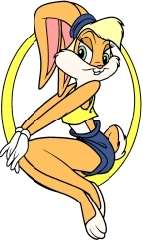
Debut: Space Jam (1996)
Tropes Related to Lola Bunny:
- Barefoot Cartoon Animal
- Bare Your Midriff: On display in her debut due to her Memetic Outfit, as shown in the image, but was then zigzagged along with other outfits in her later appearances.
- Berserk Button: She does NOT like being called "doll".
- Blue Eyes
- Canon Foreigner
- Cousin Oliver
- Distaff Counterpart: To Bugs.
- Ears as Hair
- Femme Fatale
- Furry Female Mane: she has a tuft of blonde hair on the top of her head.
- Heterosexual Life Partners: With Tina, Daffy's girlfriend; their relationship is opposite to that of their male "counterparts", with Tina playing the Straight Man to Lola's antics.
- Hotter and Sexier: the purpose of her introduction.
- Denser and Wackier: The purpose of her characterization in The Looney Tunes Show.
- Humanoid Female Animal
- Motor Mouth: In The Looney Tunes Show, Lola demonstrates a tendency to ramble on for long periods of time, much to the listener's (usually Bugs's) annoyance.
- Petting Zoo Person: In The Looney Tunes Show and New Looney Tunes.
- Remember the New Guy?: The way WB has marketed her since her debut in Space Jam.
- The Renaissance Age of Animation: Ironically made her debut in the last few years of that period.
- The Smurfette Principle: Almost certainly added to the regular Looney Tunes line-up because of this. Before her, the most common female Looney Tunes characters were Penelope and Granny.
- ↑ At least, when Executive Meddling brought on by Red Scare forced him to be.
- ↑ Though if you count the character he was created to be an expy of, his actual debut is "Porky's Pooch" (1941).